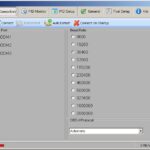Adaptive Cruise Control (ACC) and Audi Side Assist are advanced driver-assistance systems designed to enhance safety and convenience. However, like any complex system, they can malfunction. This article focuses on troubleshooting “Audi Side Assist Not Working” issues, particularly in conjunction with ACC problems. We’ll explore potential causes, diagnostic steps, and possible solutions based on a real-world case study.
Common Causes of Audi Side Assist Failure
Several factors can contribute to Audi Side Assist malfunction. These include:
- Faulty Sensors: The radar sensors located in the rear bumper are crucial for Side Assist functionality. Damage, misalignment, or obstruction can disrupt their operation.
- Wiring Issues: Damaged or corroded wiring harnesses connecting the sensors to the control modules can lead to communication errors.
- Control Module Malfunction: The Side Assist control module (J770 for the slave unit in the right side) itself can fail due to internal issues or software glitches.
- Software Bugs: Outdated or corrupted software in the control modules can cause unexpected behavior.
- Related System Failures: Problems with other interconnected systems, such as ACC or the lane change assistance system, can trigger Side Assist errors.
Diagnosing the Problem: A Case Study
A 2014 Audi A6 C7 owner reported ACC and Side Assist failure, accompanied by the dashboard warning messages “ACC and Audi braking guard: not available” and “Audi side assist: system fault!” A diagnostic scan using VCDS revealed multiple fault codes across various modules, suggesting a potentially interconnected issue.
Resetting the fault codes within the “3C Lane Change” module temporarily restored ACC and braking guard functionality. However, the “Audi side assist: system fault!” message persisted, and the systems would malfunction again after restarting the engine. Interestingly, during the periods of normal operation, the Side Assist indicator light in the right wing mirror exhibited a faint glow.
Further investigation using output tests on module 3C revealed a “Short to Ground” error for the right exterior mirror warning lamp (K234). This, along with the fault code “02850 – Control Module 2 for Lane Change Assistance (J770) 014 – Defective,” pointed towards a potential issue with the right Side Assist control module or its associated wiring. The owner also noted prior front bumper damage that required sensor calibration, raising the possibility of lingering damage or misalignment.
Potential Solutions
Based on the diagnostic findings, several potential solutions can be explored:
- Check Wiring and Connections: Thoroughly inspect the wiring harness connected to the right Side Assist control module (J770) and the right wing mirror indicator lamp (K234) for any damage, corrosion, or loose connections. Repair or replace any faulty wiring.
- Inspect and Replace Warning Lamp: Examine the Side Assist warning lamp in the right wing mirror for damage. If necessary, replace the lamp. A faulty lamp could trigger the “Short to Ground” error.
- Control Module Replacement: If wiring and lamp checks yield no results, the J770 control module may need replacement. This often requires subsequent calibration using specialized diagnostic equipment.
- Sensor Calibration: Given the previous front bumper damage, recalibrating the front and rear sensors, including the Side Assist radar sensors, could resolve potential misalignment issues.
- Software Update: Check for available software updates for the relevant control modules. Updating the software can sometimes address underlying bugs causing system malfunctions.
Conclusion
Troubleshooting “Audi side assist not working” issues requires a systematic approach involving diagnostic scanning, careful analysis of fault codes, and targeted testing. While a faulty warning lamp or wiring issue might offer a simple fix, more complex problems could necessitate control module replacement or sensor calibration. Consulting a qualified Audi technician is recommended for accurate diagnosis and repair, ensuring the optimal functionality of these crucial safety systems.


